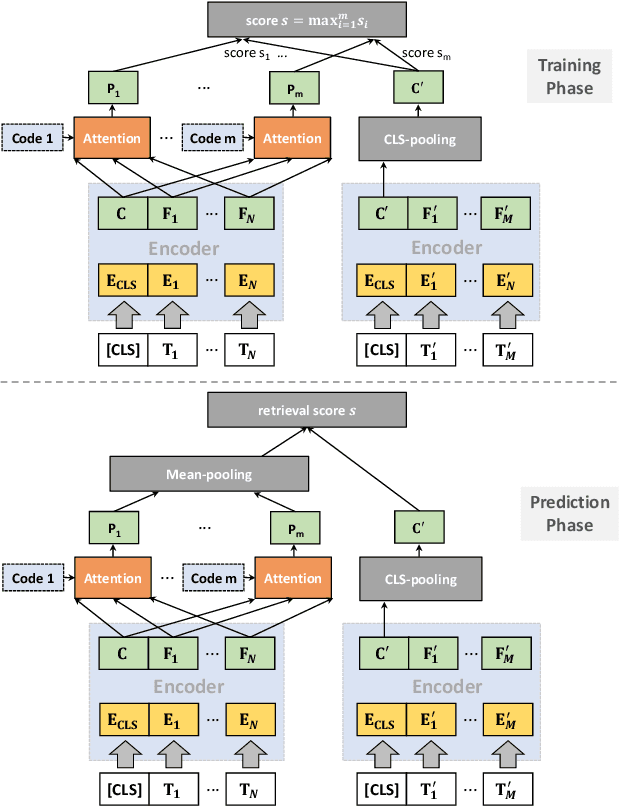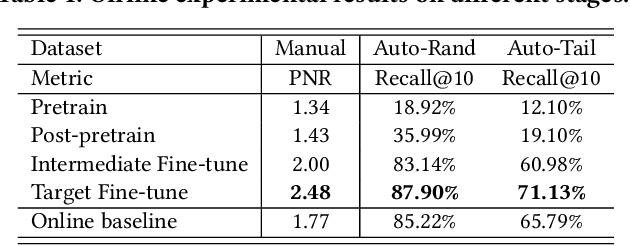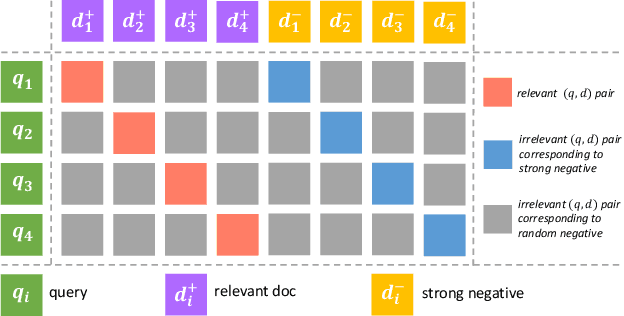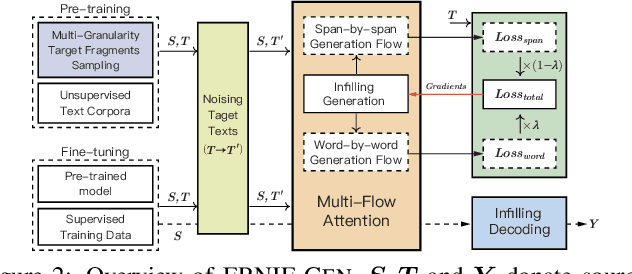Yukun Li
Incorporating Inductive Biases to Energy-based Generative Models
May 02, 2025Abstract:With the advent of score-matching techniques for model training and Langevin dynamics for sample generation, energy-based models (EBMs) have gained renewed interest as generative models. Recent EBMs usually use neural networks to define their energy functions. In this work, we introduce a novel hybrid approach that combines an EBM with an exponential family model to incorporate inductive bias into data modeling. Specifically, we augment the energy term with a parameter-free statistic function to help the model capture key data statistics. Like an exponential family model, the hybrid model aims to align the distribution statistics with data statistics during model training, even when it only approximately maximizes the data likelihood. This property enables us to impose constraints on the hybrid model. Our empirical study validates the hybrid model's ability to match statistics. Furthermore, experimental results show that data fitting and generation improve when suitable informative statistics are incorporated into the hybrid model.
DeepSeek-VL2: Mixture-of-Experts Vision-Language Models for Advanced Multimodal Understanding
Dec 13, 2024



Abstract:We present DeepSeek-VL2, an advanced series of large Mixture-of-Experts (MoE) Vision-Language Models that significantly improves upon its predecessor, DeepSeek-VL, through two key major upgrades. For the vision component, we incorporate a dynamic tiling vision encoding strategy designed for processing high-resolution images with different aspect ratios. For the language component, we leverage DeepSeekMoE models with the Multi-head Latent Attention mechanism, which compresses Key-Value cache into latent vectors, to enable efficient inference and high throughput. Trained on an improved vision-language dataset, DeepSeek-VL2 demonstrates superior capabilities across various tasks, including but not limited to visual question answering, optical character recognition, document/table/chart understanding, and visual grounding. Our model series is composed of three variants: DeepSeek-VL2-Tiny, DeepSeek-VL2-Small and DeepSeek-VL2, with 1.0B, 2.8B and 4.5B activated parameters respectively. DeepSeek-VL2 achieves competitive or state-of-the-art performance with similar or fewer activated parameters compared to existing open-source dense and MoE-based models. Codes and pre-trained models are publicly accessible at https://github.com/deepseek-ai/DeepSeek-VL2.
Graph-based Confidence Calibration for Large Language Models
Nov 03, 2024Abstract:One important approach to improving the reliability of large language models (LLMs) is to provide accurate confidence estimations regarding the correctness of their answers. However, developing a well-calibrated confidence estimation model is challenging, as mistakes made by LLMs can be difficult to detect. We propose a novel method combining the LLM's self-consistency with labeled data and training an auxiliary model to estimate the correctness of its responses to questions. This auxiliary model predicts the correctness of responses based solely on their consistent information. To set up the learning problem, we use a weighted graph to represent the consistency among the LLM's multiple responses to a question. Correctness labels are assigned to these responses based on their similarity to the correct answer. We then train a graph neural network to estimate the probability of correct responses. Experiments demonstrate that the proposed approach substantially outperforms several of the most recent methods in confidence calibration across multiple widely adopted benchmark datasets. Furthermore, the proposed approach significantly improves the generalization capability of confidence calibration on out-of-domain (OOD) data.
DeepSeek-Coder-V2: Breaking the Barrier of Closed-Source Models in Code Intelligence
Jun 17, 2024



Abstract:We present DeepSeek-Coder-V2, an open-source Mixture-of-Experts (MoE) code language model that achieves performance comparable to GPT4-Turbo in code-specific tasks. Specifically, DeepSeek-Coder-V2 is further pre-trained from an intermediate checkpoint of DeepSeek-V2 with additional 6 trillion tokens. Through this continued pre-training, DeepSeek-Coder-V2 substantially enhances the coding and mathematical reasoning capabilities of DeepSeek-V2, while maintaining comparable performance in general language tasks. Compared to DeepSeek-Coder-33B, DeepSeek-Coder-V2 demonstrates significant advancements in various aspects of code-related tasks, as well as reasoning and general capabilities. Additionally, DeepSeek-Coder-V2 expands its support for programming languages from 86 to 338, while extending the context length from 16K to 128K. In standard benchmark evaluations, DeepSeek-Coder-V2 achieves superior performance compared to closed-source models such as GPT4-Turbo, Claude 3 Opus, and Gemini 1.5 Pro in coding and math benchmarks.
Enhancing Diffusion-based Point Cloud Generation with Smoothness Constraint
Apr 03, 2024Abstract:Diffusion models have been popular for point cloud generation tasks. Existing works utilize the forward diffusion process to convert the original point distribution into a noise distribution and then learn the reverse diffusion process to recover the point distribution from the noise distribution. However, the reverse diffusion process can produce samples with non-smooth points on the surface because of the ignorance of the point cloud geometric properties. We propose alleviating the problem by incorporating the local smoothness constraint into the diffusion framework for point cloud generation. Experiments demonstrate the proposed model can generate realistic shapes and smoother point clouds, outperforming multiple state-of-the-art methods.
CoLeCLIP: Open-Domain Continual Learning via Joint Task Prompt and Vocabulary Learning
Mar 15, 2024Abstract:This paper explores the problem of continual learning (CL) of vision-language models (VLMs) in open domains, where the models need to perform continual updating and inference on a streaming of datasets from diverse seen and unseen domains with novel classes. Such a capability is crucial for various applications in open environments, e.g., AI assistants, autonomous driving systems, and robotics. Current CL studies mostly focus on closed-set scenarios in a single domain with known classes. Large pre-trained VLMs like CLIP have demonstrated superior zero-shot recognition ability, and a number of recent studies leverage this ability to mitigate catastrophic forgetting in CL, but they focus on closed-set CL in a single domain dataset. Open-domain CL of large VLMs is significantly more challenging due to 1) large class correlations and domain gaps across the datasets and 2) the forgetting of zero-shot knowledge in the pre-trained VLMs in addition to the knowledge learned from the newly adapted datasets. In this work we introduce a novel approach, termed CoLeCLIP, that learns an open-domain CL model based on CLIP. It addresses these challenges by a joint learning of a set of task prompts and a cross-domain class vocabulary. Extensive experiments on 11 domain datasets show that CoLeCLIP outperforms state-of-the-art methods for open-domain CL under both task- and class-incremental learning settings.
NVDiff: Graph Generation through the Diffusion of Node Vectors
Nov 19, 2022



Abstract:Learning to generate graphs is challenging as a graph is a set of pairwise connected, unordered nodes encoding complex combinatorial structures. Recently, several works have proposed graph generative models based on normalizing flows or score-based diffusion models. However, these models need to generate nodes and edges in parallel from the same process, whose dimensionality is unnecessarily high. We propose NVDiff, which takes the VGAE structure and uses a score-based generative model (SGM) as a flexible prior to sample node vectors. By modeling only node vectors in the latent space, NVDiff significantly reduces the dimension of the diffusion process and thus improves sampling speed. Built on the NVDiff framework, we introduce an attention-based score network capable of capturing both local and global contexts of graphs. Experiments indicate that NVDiff significantly reduces computations and can model much larger graphs than competing methods. At the same time, it achieves superior or competitive performances over various datasets compared to previous methods.
Transferable Knowledge-Based Multi-Granularity Aggregation Network for Temporal Action Localization: Submission to ActivityNet Challenge 2021
Jul 27, 2021



Abstract:This technical report presents an overview of our solution used in the submission to 2021 HACS Temporal Action Localization Challenge on both Supervised Learning Track and Weakly-Supervised Learning Track. Temporal Action Localization (TAL) requires to not only precisely locate the temporal boundaries of action instances, but also accurately classify the untrimmed videos into specific categories. However, Weakly-Supervised TAL indicates locating the action instances using only video-level class labels. In this paper, to train a supervised temporal action localizer, we adopt Temporal Context Aggregation Network (TCANet) to generate high-quality action proposals through ``local and global" temporal context aggregation and complementary as well as progressive boundary refinement. As for the WSTAL, a novel framework is proposed to handle the poor quality of CAS generated by simple classification network, which can only focus on local discriminative parts, rather than locate the entire interval of target actions. Further inspired by the transfer learning method, we also adopt an additional module to transfer the knowledge from trimmed videos (HACS Clips dataset) to untrimmed videos (HACS Segments dataset), aiming at promoting the classification performance on untrimmed videos. Finally, we employ a boundary regression module embedded with Outer-Inner-Contrastive (OIC) loss to automatically predict the boundaries based on the enhanced CAS. Our proposed scheme achieves 39.91 and 29.78 average mAP on the challenge testing set of supervised and weakly-supervised temporal action localization track respectively.
Pre-trained Language Model for Web-scale Retrieval in Baidu Search
Jun 30, 2021



Abstract:Retrieval is a crucial stage in web search that identifies a small set of query-relevant candidates from a billion-scale corpus. Discovering more semantically-related candidates in the retrieval stage is very promising to expose more high-quality results to the end users. However, it still remains non-trivial challenges of building and deploying effective retrieval models for semantic matching in real search engine. In this paper, we describe the retrieval system that we developed and deployed in Baidu Search. The system exploits the recent state-of-the-art Chinese pretrained language model, namely Enhanced Representation through kNowledge IntEgration (ERNIE), which facilitates the system with expressive semantic matching. In particular, we developed an ERNIE-based retrieval model, which is equipped with 1) expressive Transformer-based semantic encoders, and 2) a comprehensive multi-stage training paradigm. More importantly, we present a practical system workflow for deploying the model in web-scale retrieval. Eventually, the system is fully deployed into production, where rigorous offline and online experiments were conducted. The results show that the system can perform high-quality candidate retrieval, especially for those tail queries with uncommon demands. Overall, the new retrieval system facilitated by pretrained language model (i.e., ERNIE) can largely improve the usability and applicability of our search engine.
ERNIE-GEN: An Enhanced Multi-Flow Pre-training and Fine-tuning Framework for Natural Language Generation
Feb 04, 2020



Abstract:Current pre-training works in natural language generation pay little attention to the problem of exposure bias on downstream tasks. To address this issue, we propose an enhanced multi-flow sequence to sequence pre-training and fine-tuning framework named ERNIE-GEN, which bridges the discrepancy between training and inference with an infilling generation mechanism and a noise-aware generation method. To make generation closer to human writing patterns, this framework introduces a span-by-span generation flow that trains the model to predict semantically-complete spans consecutively rather than predicting word by word. Unlike existing pre-training methods, ERNIE-GEN incorporates multi-granularity target sampling to construct pre-training data, which enhances the correlation between encoder and decoder. Experimental results demonstrate that ERNIE-GEN achieves state-of-the-art results with a much smaller amount of pre-training data and parameters on a range of language generation tasks, including abstractive summarization (Gigaword and CNN/DailyMail), question generation (SQuAD), dialogue generation (Persona-Chat) and generative question answering (CoQA).
 Add to Chrome
Add to Chrome Add to Firefox
Add to Firefox Add to Edge
Add to Edge